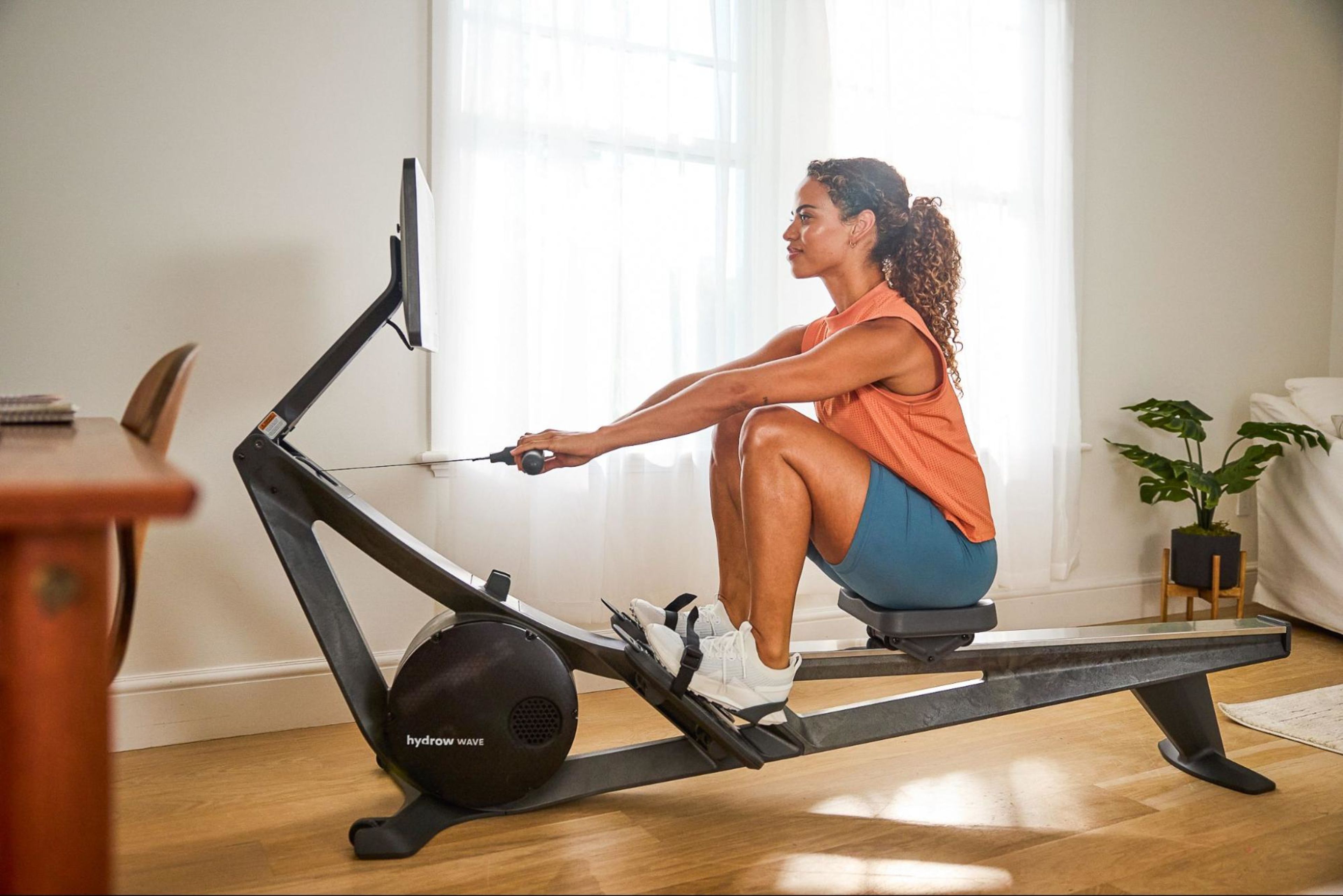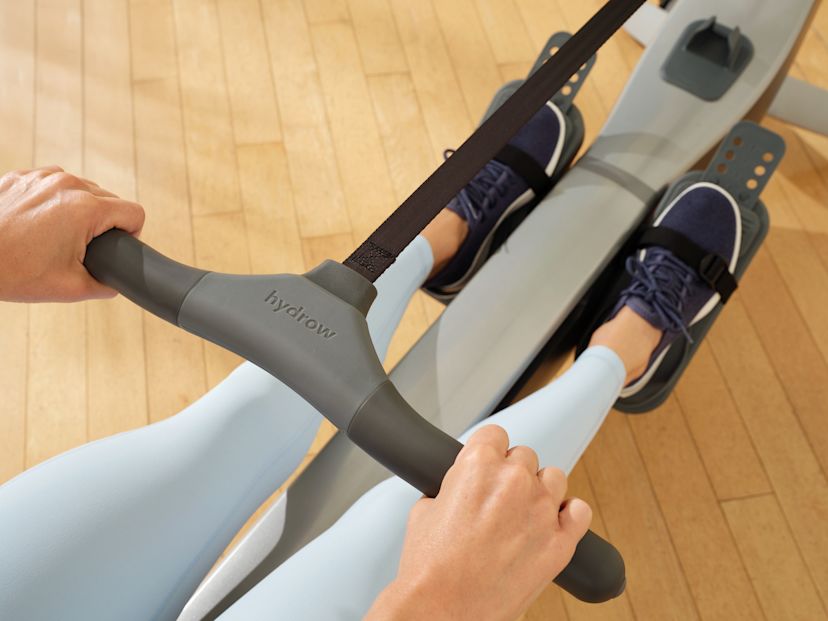19 Benefits of a Rowing Machine: What You Need to Know

Rowing workouts bring big benefits for overall health and wellness to users who make them a part of their routine. If you’ve been looking for exercise equipment to achieve your fitness goals, an indoor rowing machine can be an excellent investment.
Read on to explore 19 rowing machine benefits you can see by regularly working out on an indoor rower, including:
Let’s dig in!
1. Rowing is a full-body workout
Did you know that you can work 86% of muscles in your body with a single rowing stroke? This makes indoor rowing machines an excellent choice if you want to target more than one major muscle group as you exercise.
Other cardio workout types—such as treadmills and stationary bikes—only work your lower body, meaning you have to tack on other workout types to cover the rest of your muscles. Rowing, on the other hand, provides a comprehensive total-body workout across your upper-body, lower-body, and core muscles.
Related blog: What Muscles Does a Rowing Machine Work?
2. Rowing is an efficient workout
Because rowing targets so many muscles in your body at once, it also makes working out on a rowing machine highly efficient. You can burn more calories in less time than traditional cardio workouts, meaning you don’t have to devote as much time to your daily exercise routine to get the same results.
In fact, working out for just 20 minutes on a rowing machine can be highly effective and beneficial to your overall fitness.
3. Rowing is a low-impact workout
One of the major benefits of a rowing machine is the fact that it offers a low-impact workout. This is one of the major reasons people prefer indoor rowers over other types of exercise equipment.
Because you’re seated on your indoor rower, your joints aren’t under the repetitive high-impact load that you would experience during other high-impact activities, such as running. Additionally, when done correctly, the rowing motion is very smooth and rhythmic, reducing your risk of injury when compared to other jarring movements. And when your workouts don’t hurt, you’re more likely to stick with them!
Rowing’s low-impact nature makes it a great exercise for individuals with joint issues, such as seniors or athletes recovering from injuries.
Related blog: Are Low-Impact Workouts Effective?
4. Rowing is both a cardio and strength workout
A regular rowing routine supports both your cardio and strength goals, giving you a great bang for your buck as you incorporate these two important types of exercise into your fitness routine. You’ll burn major calories while taxing the majority of your muscles, making rowing an effective exercise for delivering both strength and cardio benefits.
Related blog: Can a Rowing Machine Get You in Shape?
5. Rowing can improve your endurance
Due to this unique combination of cardio and muscular engagement, rowing is also an excellent workout to improve your endurance. Regular rowing strengthens the heart muscle, improves circulation, and boosts your overall cardiovascular health, making your heart more efficient at pumping blood to the rest of your body. Additionally, the sustained rowing also helps improve lung capacity and efficiency, allowing you to take in more oxygen and deliver it more efficiently to your muscles.
6. Rowing machines are great for burning calories and fat
The way rowing machines engage you in a nearly full-body workout—plus their cardiovascular benefits and high calorie-burning rate—can help you burn fat faster than other fitness equipment. Again, a short, intense rowing session can burn a substantial number of calories, making it a convenient option if you’re focusing on burning fat but don’t have a ton of time on your hands. For instance, if you weigh 200 pounds, you can burn nearly 400 calories in a vigorous 30-minute rowing workout.
Because of the strength benefits of rowing, you can expect a trimmer waist and more definition in your arms and leg muscles from consistent rowing exercise.
Related blog: How Many Calories Do You Burn on a Rowing Machine?
7. Rowing helps with cardiovascular fitness
Any exercise that makes you breathe heavier and your heart beat faster makes your heart and lungs healthier, according to the National Library of Medicine, and rowing certainly fits those criteria. The healthier your heart and lungs are, the more oxygen they can pump around your body, a measure of health commonly referred to as cardiovascular fitness.

Low-impact, high reward.
Build lasting strength on a rower designed to protect your joints.
8. Rowing defines and tones your muscles
Not only does rowing improve cardio fitness, core strength, and flexibility, it also builds strength in other muscles, per the Cleveland Clinic, giving them that defined look and helping power your workouts and everyday movements.
The muscles you’ll use rowing include your deltoids, biceps, triceps, forearms, core, glutes, quads, and hamstrings. Over time, you can expect to feel (and see) these muscles getting stronger and more toned.
9. Rowing strengthens your core muscles
In addition to working both upper- and lower-body muscles, rowing challenges all the muscles in your core, including your abs, obliques, and back. Your core stabilizes you throughout the entire four-part rowing motion, according to the Cleveland Clinic, adding power to your stroke and helping to prevent injury and back pain.
10. Rowing is a convenient at-home workout
As rowing machines continue to surge in popularity, more and more people are choosing to invest in them for their home gyms. Not only do rowing machines tend to be smaller than other common types of at-home workout equipment, but many (such as the Hydrow Arc, Hydrow Origin, and Hydrow Wave) have vertical storage options to further minimize their size between uses.
11. Rowing machines are an accessible piece of workout equipment
No matter your fitness level, a rowing machine is a great place to start any fitness journey. Its low-impact nature reduces the risk of injury, and rowing machine workouts are highly customizable, meaning you can work out as hard as you want and push yourself over time once you are more comfortable with your equipment and workouts.
Related blog: Is Rowing Hard?
12. Rowing is a great workout for cross-training
If you have an existing workout routine, we have great news for you—it’s easy to incorporate rowing alongside other types of workouts and sports. By engaging multiple muscle groups across your legs, core, back, and arms, cross-training with rowing can support balanced muscle development, helping to enhance your performance in other activities.
Additionally, as a low-impact machine, rowing is a great exercise for recovery days when you don’t want to strain or overwork your muscles.
13. Rowing workouts are versatile (and fun!)
Some people may shy away from rowing because they don’t love the idea of doing such a repetitive workout. However, rowing machine workouts can be extremely engaging and diverse if you pick the right ones! Some rowing workouts—like those offered by Hydrow—are filmed on beautiful waterways around the world, transporting you from your home gym into a stunning location that (almost) makes you forget you’re working out at all.
Additionally, there are plenty of types of rowing workouts to choose from, whether you want to do high-intensity interval training (HIIT), steady-state rowing, or strength-focused sessions.
14. Rowing encourages flexibility and mobility
Rowing encourages flexibility and mobility through dynamic movements that involve a wide range of motion, continuous muscle engagement, and the promotion of joint health. The repetitive nature of rowing encourages muscles to become more pliable and adaptable, which enhances overall flexibility, while the rowing stroke involves different joint positions that stretch and lengthen your muscles.
15. Rowing workouts can improve your mind-body connection and mental health
By their very nature, rowing exercises are rhythmic and repetitive, relying on proper form, body awareness, and a focused mental headspace to complete. By rowing regularly, you can foster awareness, coordination, and focus through its unique blend of physical and mental demands.
This comes alongside the natural benefits of exercise on your mental health, as working out regularly can help reduce anxiety, depression, and stress levels.
16. Rowing workouts are cost-effective
While spending money on your health and fitness is never a bad idea, the truth is that the cost of gym memberships and fitness classes can really add up over time. While investing in any at-home fitness equipment has a higher upfront cost, you can actually end up saving money in the long run by purchasing your own machine.
17. Rowing machines make it easy to monitor your progress
Most rowing machines come with monitors that track important metrics such as distance, time, stroke rate, and calories burned, allowing you to precisely monitor your performance and track your progress over time. This also makes it easy to set and achieve specific fitness goals, whether you’re looking to hit a certain number of meters rowed or decrease your split time.
18. Rowing is a good workout for HIIT training
If you’re looking to add high-intensity interval training (HIIT) workouts into your routine, a rowing machine is a fantastic investment. This popular workout style involves performing intervals of high-intensity exercise, which you can easily do with HIIT-style rowing machine workouts.
19. Rowing machine workouts can help improve your posture
By strengthening your core and back muscles, rowing can help improve your posture and promote proper alignment of your spine. Additionally, because rowing requires coordinated, smooth movements and attention to your body position, you’ll naturally become more conscious of your posture throughout the day by rowing consistently.
Want to take advantage of the benefits of a rowing machine?
Looking for a smarter way to exercise? Rowing activates 86% of your muscles with every stroke, making it one of the most efficient ways to build total-body strength. In just 20 minutes on a rowing machine, you can get a full-body workout that boosts energy, builds endurance, and helps you move better—on and off the rower.
With Hydrow, it’s easier than ever to stay consistent. No commute. No waiting for machines. Just expert-led workouts you can do from home, whenever it works for you. Choose from rowing, strength training, mobility, yoga, Pilates, and circuit training workouts—all designed to help you move better and feel stronger, long-term.
Our workouts are filmed on location in stunning waterways around the world and led by world-class Athletes who coach you through every stroke and rep. And with 5,000+ workouts ranging from beginner to advanced, it’s easy to keep progressing no matter your level.
Every movement adds up. Start building strength that lasts with Hydrow.

Real strength keeps moving
Learn how working out with Hydrow can help support a fuller, more active life.







